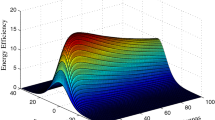Abstract
In the paper, evolutionary optimization strategy, represented by the genetic algorithm (GA) is considered as a multiuser detection (MUD) method for a multiple-input multiple-output (MIMO) wireless system. With the aim to boost lacking GA convergence, Zero-Forcing (ZF) detection is proposed as an initial processing phase. Additionally, a multi-stage GA routine is considered as a method to make the search for data estimates more effective.
Access this chapter
Tax calculation will be finalised at checkout
Purchases are for personal use only
Similar content being viewed by others
References
Tse, D., Viswanath, P.: Fundamentals of Wireless Communication, 1st edn. Cambridge University Press, New York (2005)
Barry, J.R., Lee, E.A., Messerschmitt, D.G.: Digital Communication. Springer, Netherlands (2012)
Chen, M.: Iterative Detection for Overloaded Multiuser MIMO OFDM Systems. Dissertation, University of York (2013)
Berenguer, I.: Advanced Signal Processing Techniques for MIMO Communication Systems. Dissertation, University of Cambridge (2005)
Getu, A.: Genetic Algorithm-Based Joint Channel Estimation and Data Detection For Multi-User MIMO. Dissertation, Addis Ababa University (2014)
Sivanandam, S.N., Deepa, S.N.: Introduction to Genetic Algorithms, 1st edn. Springer-Verlag, New York (2008)
Coley, D.A.: An Introduction to Genetic Algorithms for Scientists and Engineers. World Scientific Publishing Co Inc., Massachusetts (1999)
Haupt, R.L., Haupt, S.E.: Practical Genetic Algorithms. John Wiley & Sons, Hoboken (2004)
Abramson, M.A.: Genetic Algorithm and Direct Search Toolbox User’s Guide. The MathWorks Inc., Massachusetts (2007)
Simon, D.: Evolutionary Optimization Algorithms. John Wiley & Sons, Hoboken (2013)
Chipperfield, A.J., Fleming, P.J., Pohlheim, H.: A genetic algorithm toolbox for MATLAB. In: Proceedings of the International Conference on Systems Engineering, 6–8 September, pp. 200–207. Coventry, UK (1994)
Acknowledgment
The presented work has been funded by the Polish Ministry of Science and Higher Education within the status activity task “Wireless networks – multiple access, transmission, error protection” in 2018 (Grant No. 08/81/DSPB/8123).
Author information
Authors and Affiliations
Corresponding author
Editor information
Editors and Affiliations
Rights and permissions
Copyright information
© 2019 Springer International Publishing AG, part of Springer Nature
About this paper
Cite this paper
Khafaji, M.J., Krasicki, M. (2019). Genetic-Algorithm-Driven MIMO Multi-user Detector for Wireless Communications. In: Zamojski, W., Mazurkiewicz, J., Sugier, J., Walkowiak, T., Kacprzyk, J. (eds) Contemporary Complex Systems and Their Dependability. DepCoS-RELCOMEX 2018. Advances in Intelligent Systems and Computing, vol 761. Springer, Cham. https://doi.org/10.1007/978-3-319-91446-6_25
Download citation
DOI: https://doi.org/10.1007/978-3-319-91446-6_25
Published:
Publisher Name: Springer, Cham
Print ISBN: 978-3-319-91445-9
Online ISBN: 978-3-319-91446-6
eBook Packages: Intelligent Technologies and RoboticsIntelligent Technologies and Robotics (R0)




